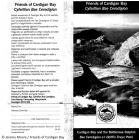Gellir lawrlwytho cynnwys at ddefnydd anfasnachol, megis defnydd personol neu ar gyfer adnoddau addysgol.
Ar gyfer defnydd masnachol cysyllwch yn uniongyrchol gyda deilydd yr hawlfraint os gwelwch yn dda.
Read more about the The Creative Archive Licence.
Disgrifiad
Professor Peter Morgan was the Keeper of Zoology for the Department of Zoology, at the National Museum of Wales, between 1978 - 1996.
Over the years, Professor Morgan attended various strandings and incidents, some of which, he adds, it paid to have a 'strong stomach' to attend. This includes the stranding of a humpback whale at Aberthaw in 1982.
Recollection as follows:
"It pays to have a ‘strong stomach’ or a weak sense of smell as a vertebrate zoology museum curator. This was certainly witnessed by the result of two of the many calls received by the Department of Zoology at the National Museum of Wales.
The first in 1982 informed me that a large whale was washed ashore at Gileston shingle beach, adjacent to Aberthaw power station. Sure enough it was a young Humpback Whale nearly 30 foot long which had not long since died, but it was the other side of the sea wall and 100 yards or more from any direct access.
No Humpback whale had been stranded in British waters since the beginning of the century and it was vitally important to collect samples and if possible to preserve for it for display. So with a small team the flensing and cutting of the blubber and meat commenced and continued for a few days gratefully assisted by students from Atlantic College. St. Donats.
Photographs attest to the final stages of the removal of flesh from the bones on site but not the smell, which greatly reduced the number of people who over the period had visited to see it and what we were doing.
Eventually a low loader was allowed into the power station and the skeleton was crane lifted to be finally cleaned and degreased. It proved to have been struck by a large piece of timber near the eye, probably in the very severe storms in the south-western approaches in the days before, eventually leading to its death.
However as a specimen it provides a salutary reminder of the continued threats to whales in a major exhibition called Song of the Dying Whale and is still displayed at the National Museum of Wales in Cathays Park."
Peter Morgan





Oes gennych chi wybodaeth ychwanegol am yr eitem hon? Gadewch sylwad isod
Sylwadau (0)
Rhaid mewngofnodi i bostio sylw